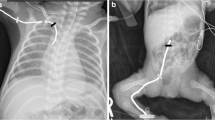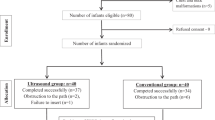Abstract
Background
Neonates commonly require central access, and in those with very low or extremely low birthweight this can be challenging. Described here is a technique that uses ultrasound guidance in the placement of peripherally inserted central catheters (PICC) in neonates and an analysis of outcomes.
Methods
A retrospective chart review was conducted of all patients below 1500 g that underwent placement of a peripherally inserted central catheter under ultrasound guidance between January 1, 2012, and December 31, 2014 at a single center. All patients had multiple previous attempts at PICC placement by experienced NICU vascular access nurses prior to referral. Complications were determined based on clinical and procedural notes.
Results
A total of ten patients were found during the study period. The average estimated gestational age was 29.8 weeks (range 26–38 weeks).The average weight at the time of PICC insertion was 968 g (range 485–1390 g). All attempts at placement were successful. There were no complications directly related to PICC insertion.
Conclusion
Ultrasound guided PICC line placements using ultrasound is an effective technique, which can be applied to very low and extremely low birth weight infants, with excellent success rates and a low risk of complications.



Similar content being viewed by others
References
Asheim P, Mostad U, Aadahl P (2002) Ultrasound-guided central venous cannulation in infants and children. Acta Anaesthesiol Scand 46:390–392
Arul GS, Livingstone H, Bromley P, Bennett J (2010) Ultrasound-guided percutaneous insertion of 2.7 Fr tunneled Broviac lines in neonates and small infants. Pediatr Surg Int 26:815–818
Dambkowski CL, Abrajano CT, Wall J (2015) Ultrasound-guided percutaneous vein access for placement of Broviac catheters in extremely low birth weight neonates: a series of 3 successful cases. J Laparoendosc Adv Surg Tech 25(11):958–960
Goldstein SK, Pryor H, Salazar JH et al (2015) Ultrasound-guided percutaneous central venous access in low birth weight infants: feasibility in the smallest of patients. J Laparoendosc Adv Surg Tech 25(9):767–769
Can E, Salihoglu O, Ozturk A et al (2014) Complication profiles of central and non-central 1 Fr PICCs in neonates weighing <1500 g. J Matern Fetal Neonatal Med 27(15):1522–1525
Jijeh AMZ, Shaath G, Kabbani MS et al (2014) Ultrasound guided vascular access in pediatric cardiac critical care. J Saudi Heart Assoc 26:199–203
Katheria AC, Fleming SE, Kim JH (2013) A randomized controlled trial of ultrasound-guided peripherally inserted central catheters compared with standard radiograph in neonates. J Perinat 33:791–794
Subramanian S, Moe DC, Vo JN (2013) Ultrasound-guided tunneled lower extremity peripherally inserted central catheter placement in infants. J Vasc Interv Radiol 24(12):1910–1913
Evans M, Lentsch D (1999) Percutaneously inserted polyurethane central catheters in the NICU: one unit’s experience. Neonatal Netw 18(6):37–46
Linck DA, Donze A, Hamvas A (2007) Neonatal peripherally inserted central catheter team: evolution of outcomes of a bedside-nurse-designed program. Adv Neonatal Care 7(1):22–29
Racadio JM, Doellman DA, Johnson ND et al (2001) Pediatric peripherally inserted central catheters: complication rates related to catheter tip location. Pediatrics 107(2):e28
Colacchio K, Deng Y, Northrup V, Bizzarro MJ (2012) Complications associated with central and non-central venous catheters in a neonatal intensive care unit. J Perinat 32:941–946
Hind D, Calvert N, McWilliams R et al (2003) Ultrasonic locating devices for central venous cannulation: meta-analysis. BMJ 327(7411):361
Author information
Authors and Affiliations
Corresponding author
Ethics declarations
No sources of funding were used in the preparation of this manuscript.
Rights and permissions
About this article
Cite this article
Johnson, K.N., Thomas, T., Grove, J. et al. Insertion of peripherally inserted central catheters in neonates less than 1.5 kg using ultrasound guidance. Pediatr Surg Int 32, 1053–1057 (2016). https://doi.org/10.1007/s00383-016-3959-1
Accepted:
Published:
Issue Date:
DOI: https://doi.org/10.1007/s00383-016-3959-1




